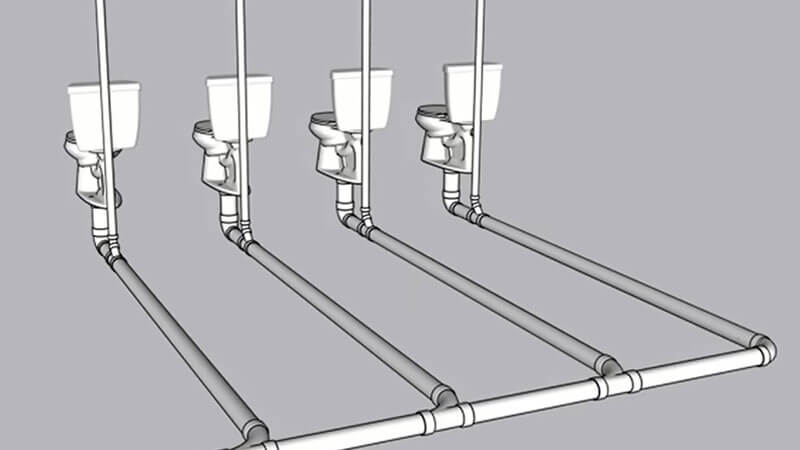In modern homes, it is rare to have no windows in the bathroom. However, some bathrooms have trouble getting outside air. Not having access to outside ventilation in the bathroom doesn’t mean you have to go without ventilation. But how to vent a bathroom with no outside access?
The most effective option is to speak with an HVAC consultant if you are unsure of how to effectively provide high-quality ventilation in your bathroom. But before that, we’ve some tips for you.
Yes, there are some low-budget but effective homely ways to ventilate a bathroom without outside access; Such methods include extra exhaust fans, household fans, ductless fans or dehumidifiers, expanding your ductwork, and so on.
Though these ways actually work less or more depending on your condition, we will try to help you to get some effective techniques in this article, which will guide you to lead the fresh air outside when there is no way to go. Let’s start!
Why Your Bathroom Needs Ventilation
1. Excess moisture stays in the air whenever you bathe or shower
If you don’t have a lot of ventilation, the moisture will linger in the air and cause your mirrors to fog up.
2. Moisture on the wall
When you take a bath or a shower, condensation may start to build up on the walls or other bathroom fixtures.
3. Unpleasant odors come from your toilet
You’ll notice that smells from your toilet stay in the bathroom for longer since the foul air won’t be able to exit.
4. Stuffy and a musty odor
If you keep the door closed, the air in your bathroom gets stuffy or humid, and there might even be a musty odor.
5. Stains or discoloration
Because they thrive in wet conditions, mold develops more quickly when there is insufficient ventilation. Your bathroom will become stained and discolored as a result.
6. Faded walls
Without enough ventilation, water will begin to gather on your bathroom wall and cause discoloration or water damage.
6 Effective Ways to Vent a Bathroom
A bathroom without outside access may be ventilated in a variety of ways, although some are more effective than others. So first, check out our six ways, then choose the one that works best for your bathroom.
Level 1: Low-Level Ventilation
These ways of ventilation will take time, be less efficient as well less costly. You may have to spend 50-100$ or less than that to apply these techniques.
1. Let the bathroom door open after every use

Open the bathroom door a bit while you’re taking a shower to let the moisture out. To help it dry out and allow fresh air to enter, keep the bathroom door open for at least 15 minutes after you’re done using it.
If you have a shower curtain, pull it closed once you’re done because if you leave it pushed to one side, mold and mildew may grow. Again, Leave the glass shower door open to let the chamber air out if you have one.
2. A household fan can help ventilate a bathroom

A household fan, such as a box or table fan, may help you with bathroom ventilation. Installing a fan just for your bathroom might be helpful if you’re looking for an easy approach to eliminate dampness and smells there.
However, standard fans are not the most effective ventilation, and for optimal effects, they should be used in combination with an open window or vent.
Level 2: Medium-Level Ventilation
These techniques are more costly than level 1. It will cost 200-400$, depending on your effort and ability. However, these techniques are more efficient and homely as well.
1. A ceiling vent can be the best option

Without having access to the outside, a ceiling vent is a common method of bathroom ventilation. It can be useful in lowering moisture and provides a space for the humid air in your bathroom to escape. It either transports air horizontally to one of your house’s outside walls or vertically up through the roof.
If you already have ductwork, you may install a bathroom fan on your own; however, if you’re starting from scratch, you should hire an HVAC contractor.
2. Your bathroom can be effectively ventilated with ductless fans

Without the need for ducting or a ceiling cutout, ductless recirculating fans are a fantastic way to ventilate your bathroom. Recirculating fans circulate air through an activated charcoal filter to remove smells. However, they are ineffective in removing moisture from the air.
Recirculating fans are perfect for providing a little circulation to half of the bathrooms that don’t have a tub or shower because they are ductless and need less time to install. Do not forget that you must replace these filters once a year.
Level 3: High-Level Ventilation
These ventilation techniques are costlier on our list, and we may need to consult professionals. You may have to spend about 500-1500$ to apply these techniques.
1. Wall vent fan for better ventilation

If your bathroom is on an outside wall, a wall vent will always function since it drags inside air out of your house via the wall. Although floor or ceiling vents may be put directly on an outside wall without the need for extra ductwork, they are typically smaller than wall vents.
Install an external vent cover on the outside of the vent to assist prevent backdrafts since air may blow inside through a wall vent. Wall vent installation often costs less than $1,000 USD.
2. Install wider ducts in your walls
If your bathroom already has vents, but moisture is still forming, you may increase airflow by adding larger ducts to your walls. It might be a difficult, messy task to expand your ducting, but the effects may be worth it. To give moist air additional opportunities to exit, you may also add several vents to your bathroom.
It takes a lot of effort to replace and install new ducts inside your walls. To avoid causing system damage while replacing or installing new vents, get suggestions from qualified HVAC professionals. The price is determined by the size, length, and labor costs of your new ducts.
Guidelines for ventilation equipment upkeep
- Replace the air filters in ductless or recirculating fans once a year.
- Once or twice a year, “clean exhaust fans” with a moist cloth to eliminate dust and maintain it operating efficiently.
- If a bathroom fan is no longer effective in preventing mirrors or shower doors from fogging up, replace it.
Final Thoughts!
For healthy and clean living, proper ventilation is always important. However, you may be aware that poor ventilation can have a number of negative effects on your health.
Mold of all kinds and high humidity can be harmful to your health. They bring on respiratory conditions that might have detrimental effects. In addition, your skin and nails are particularly vulnerable to damage from fungi.
But efficient ventilation protects your health in addition to creating a pleasant environment. As a result, maintaining good ventilation in your bathroom is essential, as we addressed in our article. Hope you like it.
See you in the next guide. Until then, take care!
Hello! this is John Cox. If I’m not wrong, you love Home. Right? And you already met one of them who’ve been in this field since 2005 and still go on. According to my interest, I’ve started this blog to share my thoughts about Home sectors, and you’ll love it.


